Last weekend I was at Greg Ellifritz’s “Snubnose Revolvers for CCW/Self-Defense” class in Clarksville, Ohio. I had been looking forward to this class for a long time, and my only disappointment was that Mike couldn’t join me. Today’s post will be an AAR of this class.
I admit I had some cognitive dissonance last Saturday afternoon. As soon as Greg’s class was over I discovered my normal Saturday post had failed to go live. I logged in and updated it, then sat there and read it. The article in question (in case you didn’t read it) talked about the struggles of the RevolverGuy. I almost didn’t want to post it because after Greg’s class I was feeling pretty confident with my revolver skills. Let’s look at why.
Full Disclosure: I paid full price for attendance to the course and all related costs, including travel and two nights’ lodging. I was not asked to write a review, nor was my review influenced or coordinated in any way with Greg Ellifritz, Active Response Training, or G4 Personal Safety.
Classroom Portion
I didn’t realize it going in but this was Greg’s first revolver class. Dann at G4 Personal Safety had talked Greg into running a revolver class, and I’m glad he did. G4 is literally in Dann’s backyard. Despite being a small range, it was a very nice facility with plenty of shade, well manicured yard-lines, and a perfect amount of space for twelve shooters in two relays.
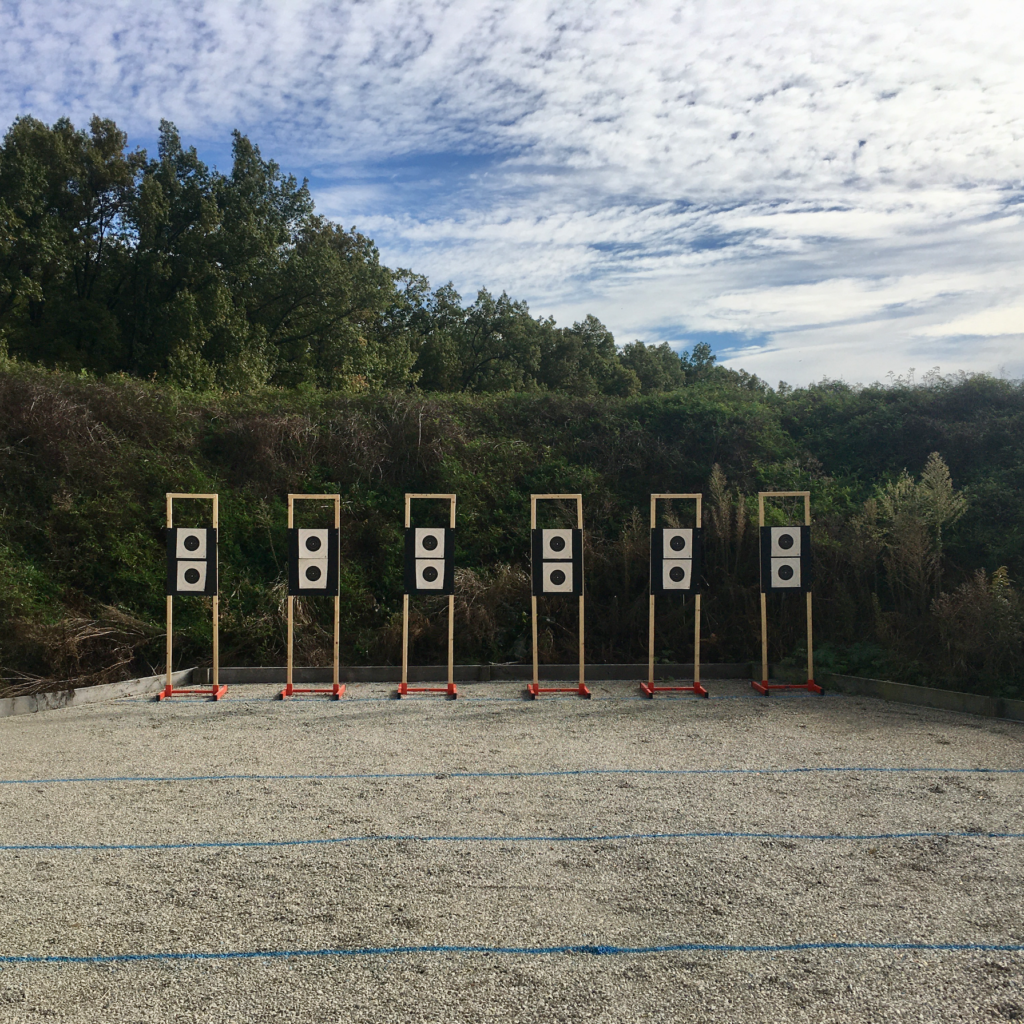
The training day began at 9 AM in the classroom. Greg went over range safety procedures and assigned emergency duties (primary medics, EMS callers, and runners). Greg also pointed out that he runs a hot range (which I like) and explained his expectations around that. With safety covered he talked a bit about the strengths and weaknesses of revolvers, ammunition selection, and after clearing guns on the range, went into “show and tell.” Everyone showed the class what gun, holster, and loading devices they were using.
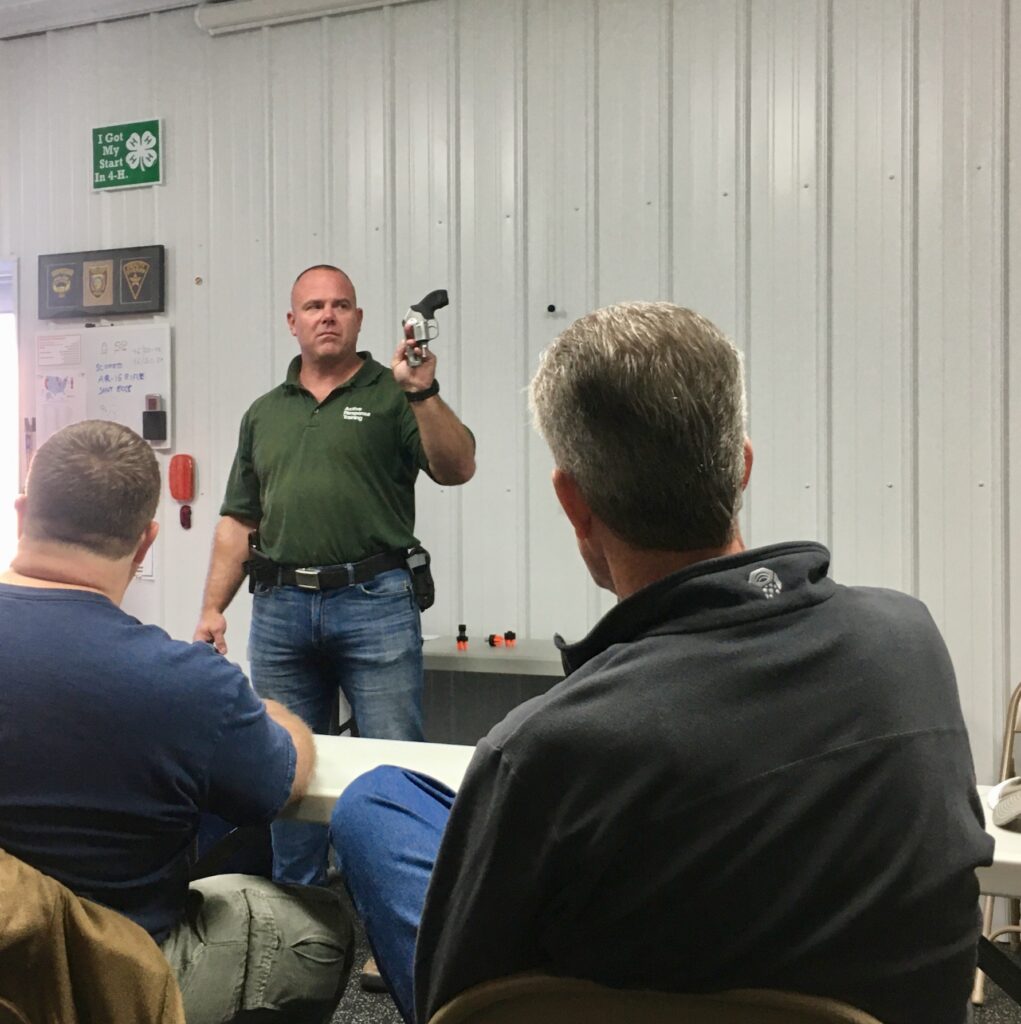
This portion was interesting to me on its face; there was a very diverse group of revolvers in the class. Greg used this as a great opportunity to point out the benefits – and problems – of various guns. I thought we might get to see a live version of “Don’t Dig the Rig” but all of the attendees had solid wheelguns (Colt, Kimber, Ruger, and S&W) and quality holsters. Don’t worry – I know you guys all want to know what guns were there; I’ll cover it toward the end.
The most important thing that came out of the classroom session for me personally: the answer to, “is the snubby enough gun?” Greg answered this in a way that makes me think about revolvers a bit differently. He said that revolvers are a “one bad-guy gun,” sufficient for most things civilians are likely to encounter, but ill-equipped for multiple adversaries. It’s a simple concept, but a lot for me to wrap my head around. With this sobering thought in mind we headed out to the range.
Range I: Morning
When we got out to the range we divided into two relays. The first exercise was a simple five-shot, slow-fire drill. The first purpose of this drill was to quickly assess everyone’s grasp, stance, and marksmanship. This was immediately followed by something I’ve never seen done before. Greg had us load up a primed case. We dry-fired through the cylinder until we popped the primed case. This was to give everyone some familiarity with what a squib load would sound and feel like in the event one occurred during the training day.
The class was a competent group of shooters and after that initial drill the pace began to pick up. We moved immediately into “worst case scenario” reloading: reloading loose rounds. Greg’s technique to grasp the revolver in the left hand, ejector rod between the fingers. Create a cup with the palm for loose rounds, and load them with your right hand. As one would expect from a true revolver class, Greg really dug into the details. One detail I enjoyed was thinking about how to load two rounds if you can only get two in: side-by-side, or opposite from each other in the cylinder?
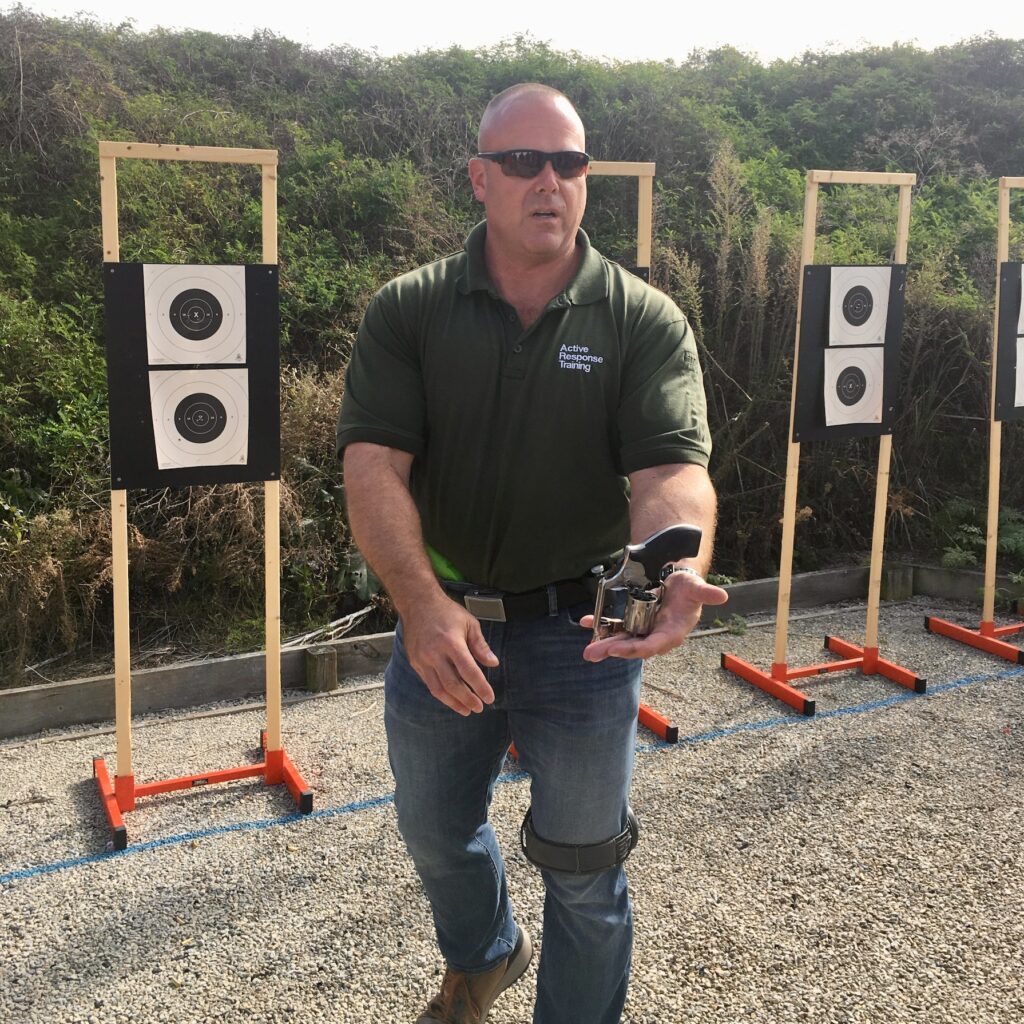
Greg’s thought was that putting them opposite each other (in a six-shooter) is ideal. This means if you close the cylinder in the worst case scenario you only have to through two dry clicks before getting a bang. Of course this has to be balanced with other factors; if it’s massively faster and more secure to get two in side-by-side, go with that. But it’s what I like to see in a revolver class – someone who is seriously thinking about the minutia of running a revolver.
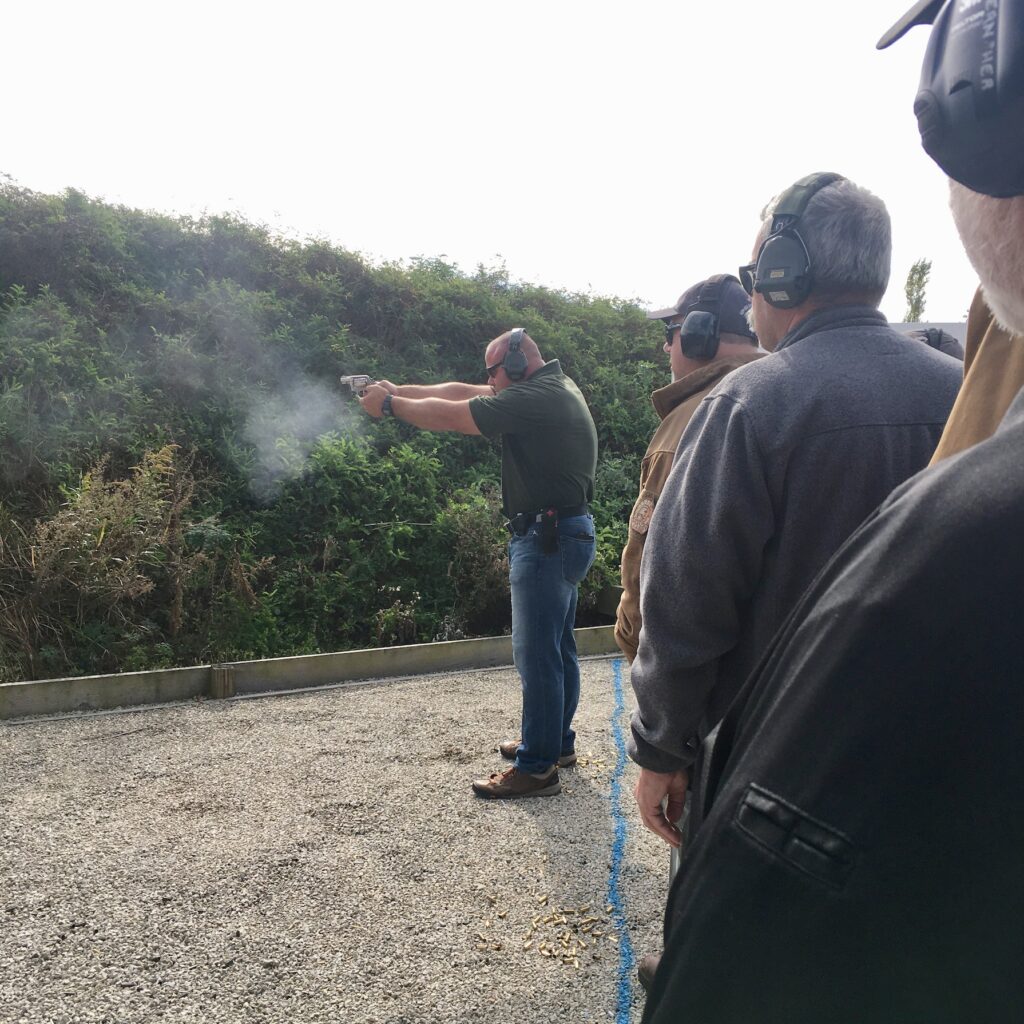
We ran through several iterations of this, and worked on tactical reloads using this technique. Due to this class I may have updated my mental model of the tactical reload, and that may be the subject of a future article.
After loading loose rounds we moved on to reloading with strips. Greg provided his preferred tools and techniques, but also demonstrated the various other ways to setup and utilize reloading strips. We finished up the morning session with a timed, “rolling thunder” event with the relays competing against each other (I’m sad to say the second relay won the day!).
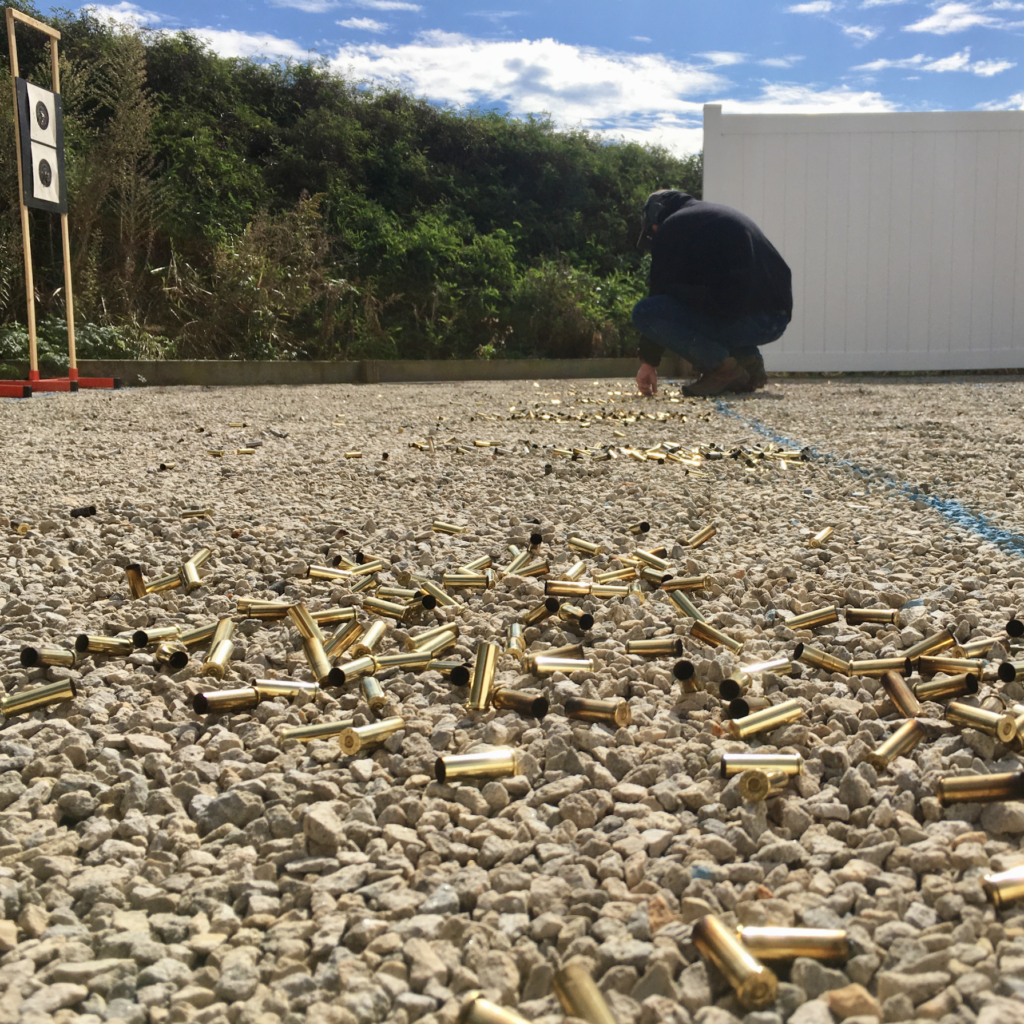
Range II: Afternoon
After the provided lunch (thanks, Dann!) we got back on the range and got into speedloaders. Greg demonstrated the Universal Revolver Reload and went through the pros and cons of various speedloaders. Greg also had a huge box of spare loaders (and holsters) that he made available, including HKSs for almost everything, Jetloaders, and Safariland Comp I/II/IIIs. We worked several iterations of reloading, interspersed with some shooting drills (draw and fire 1, draw and fire 2, etc.).
Greg also had us shoot a really interesting demonstration. At three yards, on three clean targets, we fired three cylinders. The first was fired as slowly as we wanted, with the goal of five (or six) touching holes. The next was fired at a 1 shot/second cadence. The third was fired at 1 shot every half second. The results truly surprised me: most shooters ended up with three groups that were nearly identical in size. Granted, we were close-in, but I know from experience that the results would have been drastically different with autoloaders. This demonstrated a very tangible benefit of revolvers: the ability to fire quickly with a far lower expansion in group size.
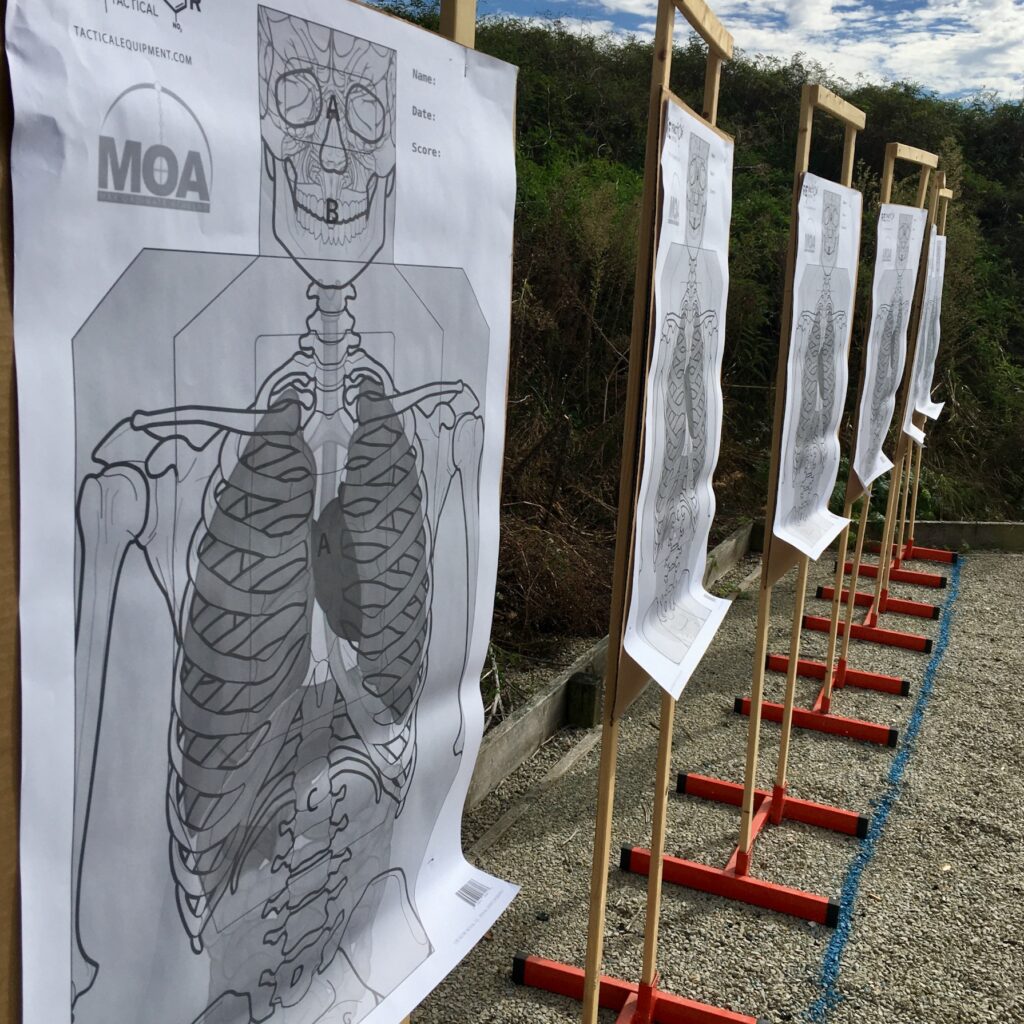
At this point we switched to anatomical targets and jumped into a discussion of the failure drill. Greg made a great point here, and one of the ones that will most influence how I think about revolvers. I’ll paraphrase: “if you’re shooting an attacker in the chest with a 5-round gun and it’s not working, when do you switch to head shots?” I’ll admit that since I’ve switched to a flat gun for day-to-day carry, I haven’t given that a ton of thought. The old failure/Mozambique drill (two to the chest, one to the head) is still a worthwhile drill, and probably a worthwhile model for revolver shooters to consider.
Next, we spent quite a bit of time on shooting strong- and weak-hand only. We worked on transferring the gun from one hand to the other. We did a “fam-fire” on shooting from retention, and we shot through coat pockets. Greg provided a bag of thrift-store coats for the purpose. I had one big lesson-learned from this portion: exposed hammers are not ideal for inside-the pocket shooting! The hammer on Greg’s Model 12 was caught up in fabric during his demonstration, and I had the exact same results. If you have an exposed hammer and carry a revolver in a coat pocket, be aware of this!
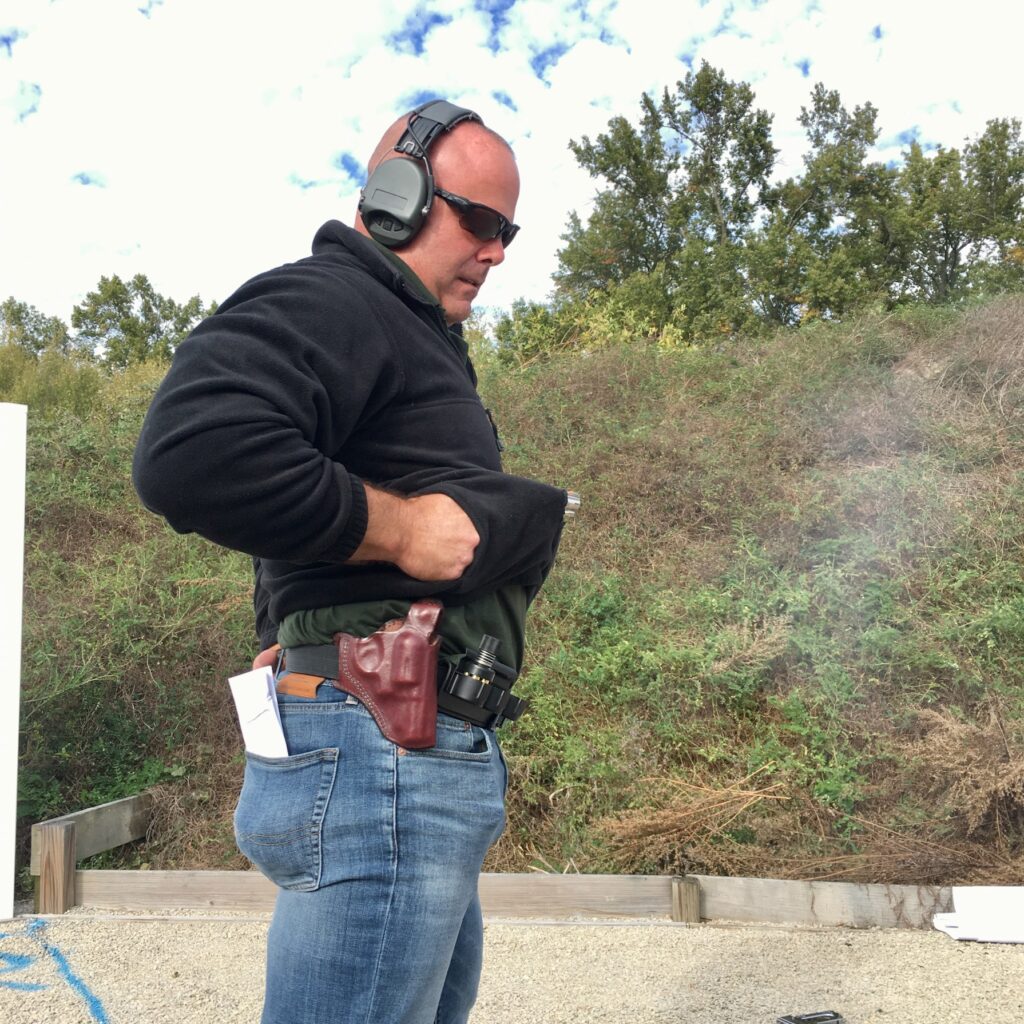
Range III: Tests & Qualifications
The last portion of the formal range training was to run a couple of tests/qualifications. The first was a 10-shot revolver test:
Target: NRA B-8 repair center
Distance: 10 feet
Setup: five rounds in gun with one reload available
Time Limit: 20 seconds
Drill: Begin with revolver in weak hand. On the buzzer fire two rounds WHO. Switch gun to strong hand and fire three rounds SHO. Reload and fire five rounds two-handed.
The drill must be completed in under 20 seconds to count. I managed to acquit myself reasonably well, being a couple seconds under time and scoring a 97 out of 100 points possible. Greg recommends achieving a minimum of 90%.
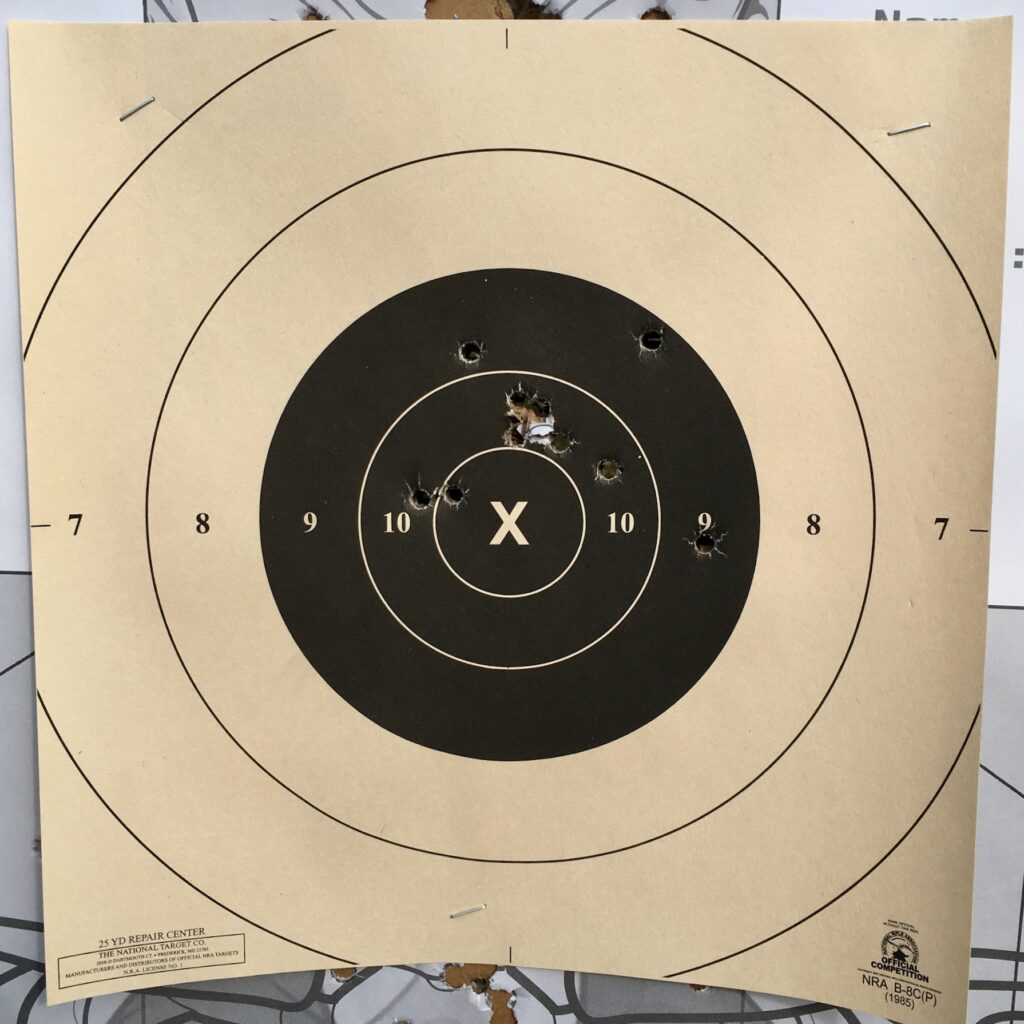
The qualification we fired was the Ohio Peace Officer Training Academy semi-auto pistol qualification. I’m not going to type up the full course of fire, but you can read about it here. I’m happy to report that I and several others scored 25 out of 25 possible points, and the majority of the class cleared the 20-point minimum to pass. Those that didn’t pass got within just a couple of points.
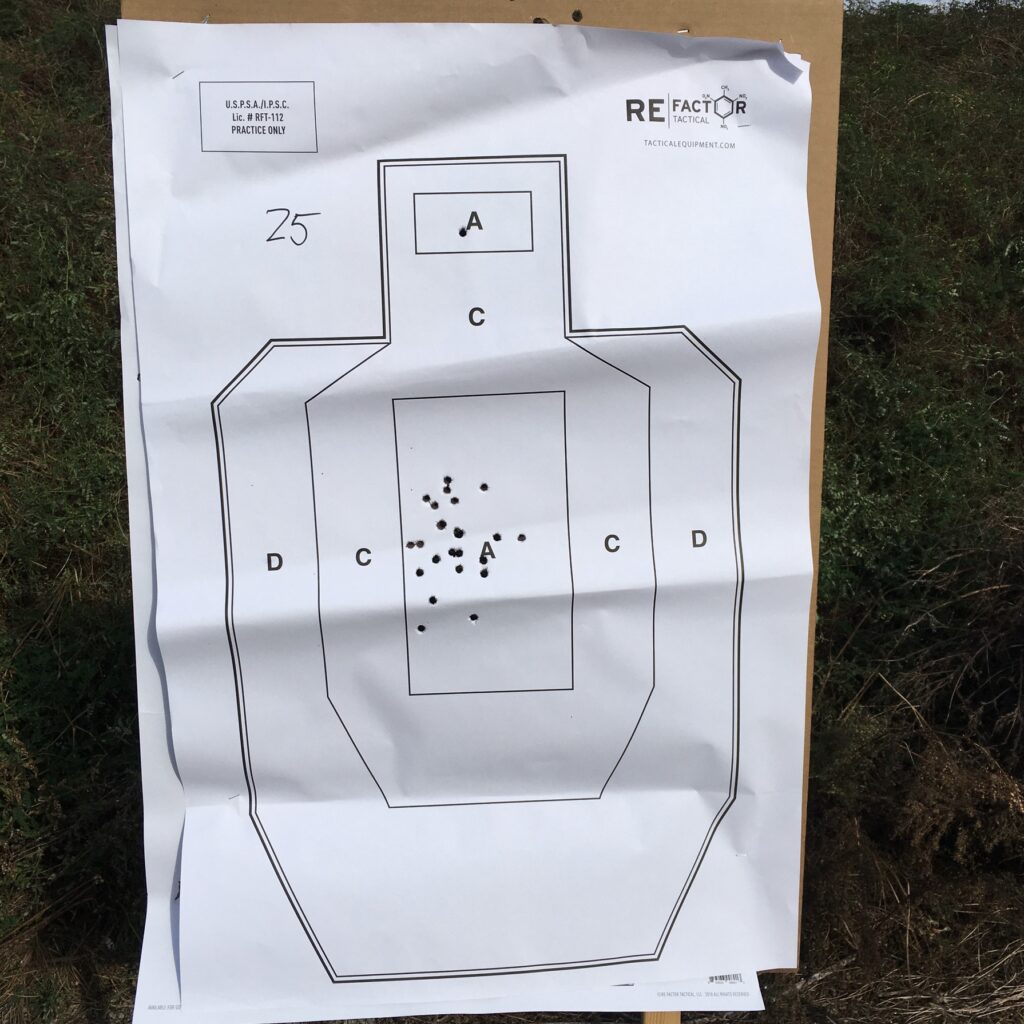
General Thoughts on Instruction
Since this is a review of the class, I want to offer a couple of thoughts on the conduct of the class and the instruction itself. As someone who makes his living teaching adults, and who takes great pride in the same, I’m always interested in watching other instructors.
First, the classroom and range were top notch. At one point Dann said something along the lines of, “I know it’s not much” but I don’t think anyone could have been more pleased. It was tidy, obviously cared for and well maintained. The range itself was ideal for the group size we had: plenty big, but small enough to keep the group close together. The classroom was clean and squared away and again, and it’s obvious Dann takes pride in his facility. I know I bragged about the facility earlier in the review, but I really liked it.
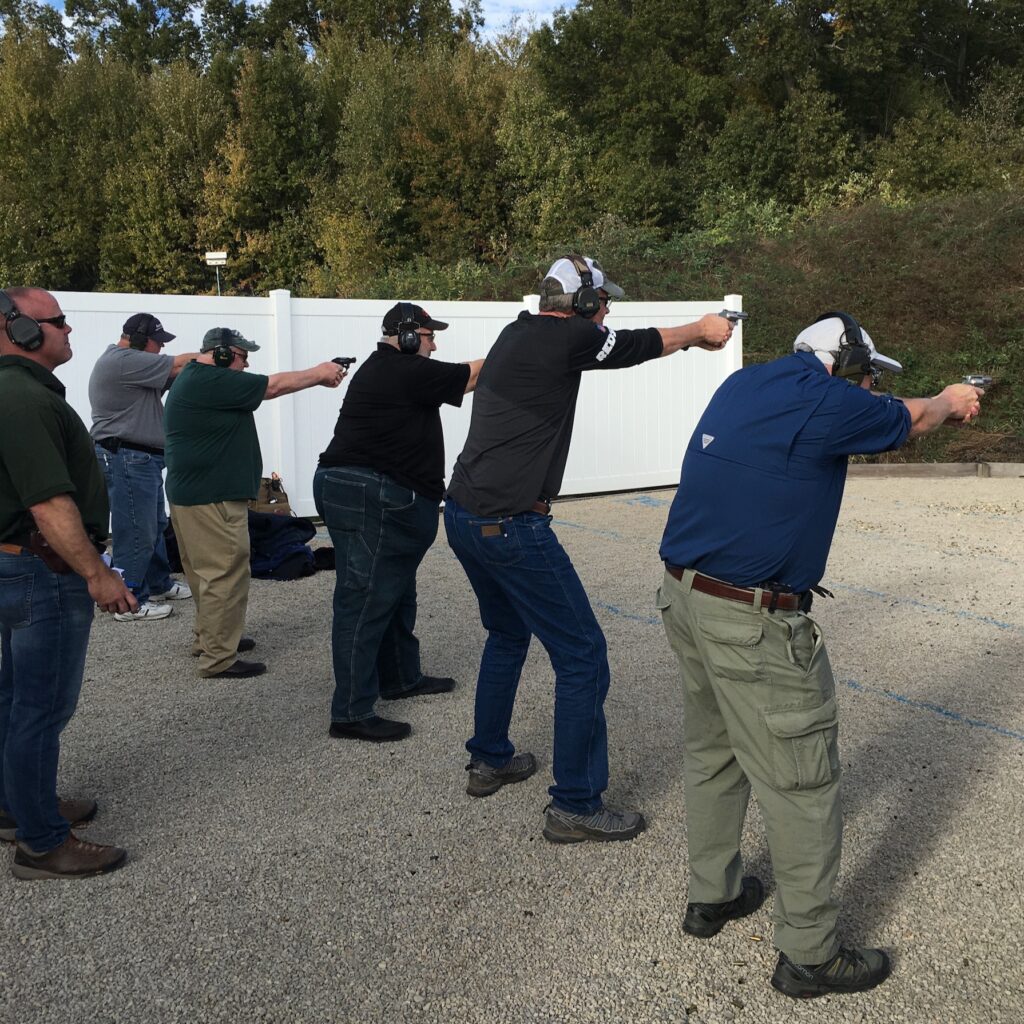
The instruction was fantastic. I like Greg’s style. First, he knows his material thoroughly. Just when I would think, “I wonder if he’s going to mention…” he would mention it. He also has a strong ability to convey knowledge. It’s one thing to know a lot, and quite another to be able to convey it to others. The class was extremely professional. Exercises and drills were demonstrated before students were expected to perform. Questions were answered in-depth, and everything was conducted safely.
One other thing: at the end of the day Greg asked if I was going to write a rewiew. When I indicated that I was he handed me six folded pages containing the day’s curriculum and said, “this might help.” Not very many instructors are so open with their material. I have also attended Greg’s Tactical First Aid and feel completely confident recommending any of his training.
My Class Equipment
I’ll speak briefly about the gear I ran in the class. I primarily shot my Colt King Cobra. I shot a couple stages with my 640 Pro Series, but if I’m carrying a revolver these days, it will be the Colt. I carried it in a Kramer OWB, and reloaded from a HKS 10 (K-frame) speedloader and Bianchi/DeSantis strips.
I ended up firing about 250 rounds, and the King Cobra performed really well. In fact, you can probably chalk my OK accuracy up more to the gun than any particular skill on my part. With its smooth trigger, and the weight and large grip of 3-inch, all-steel gun it almost shoots itself. My only issue with the King Cobra was the ejector rod. As I posted on Patreon a couple of weeks ago, I’m starting to experience the stuck ejector rod issue. This issue got successively worse as the class progressed. I suspect that the knurling at the tip is getting steadily more worn down, and more of it is being shoved in to the crane. I think the fix for this (on Greg’s recommendation) is to file down the knurling to the same diameter as the ejector rod.
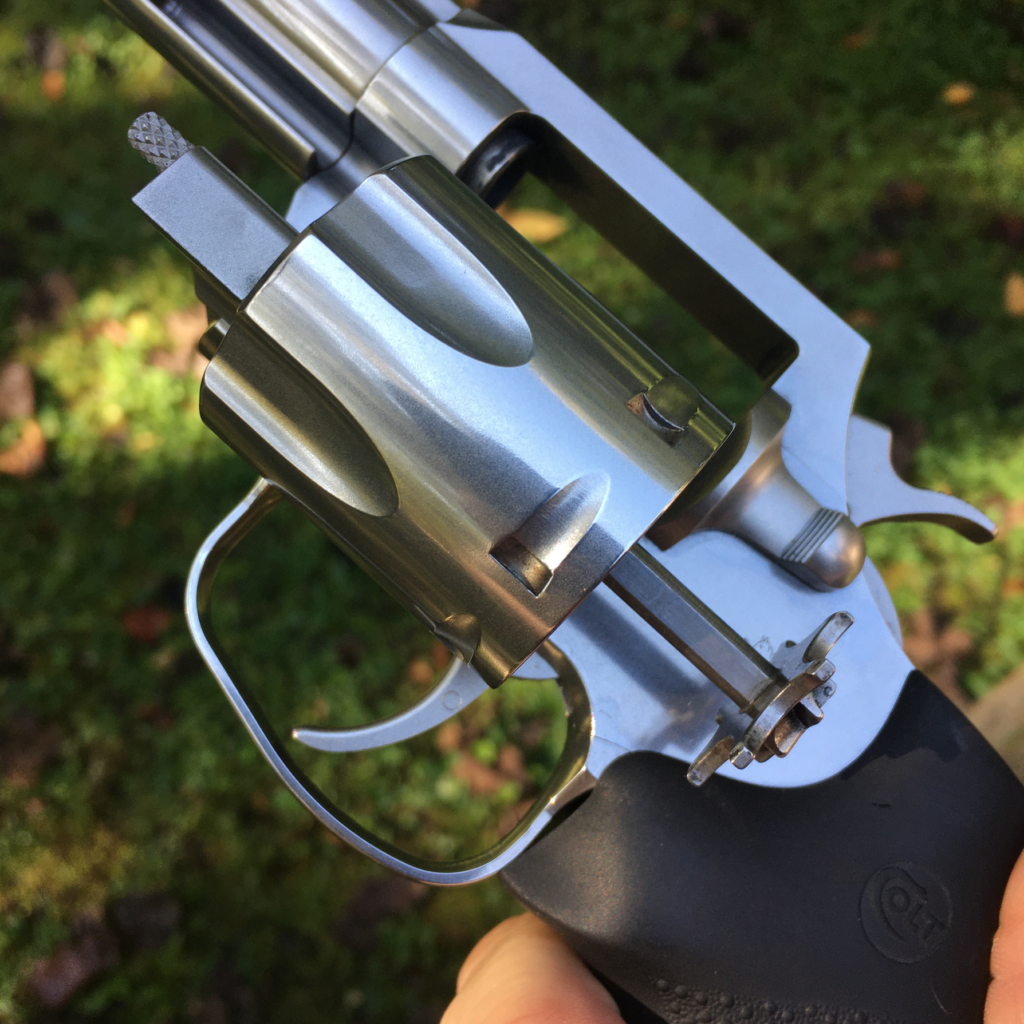
The HKS loader, carried in a DeSantis Second Six, worked very well, too. I would have no issue carrying this combo. As expected I also had no issued with the Bianchi Speed Strips and DeSantis Swift Strips. I brought along my 640 Pro as a backup gun, carried in my Dark Star Gear holster, along with various reloading devices.
Show and Tell: RevolverGuys and Revolvers
Now we get to the best part of the class: the people and their revolvers. I also want to mention the other students. This was an exceptionally good group (and believe me, that is not universally the case). Some fantastic questions were asked, everyone stayed on task and on topic. It was also great to meet a few other RevolverGuys! Neil sat beside me in class and shot beside me on the line… and he brought my 640 Pro’s identical twin! Kevin, who shot near me on the line, heaped a ton of praise on RevolverGuy (the blog – not me), as did others. I’m sorry I’m not mentioning everyone’s name here, but I had a positive interaction with everyone that attended.
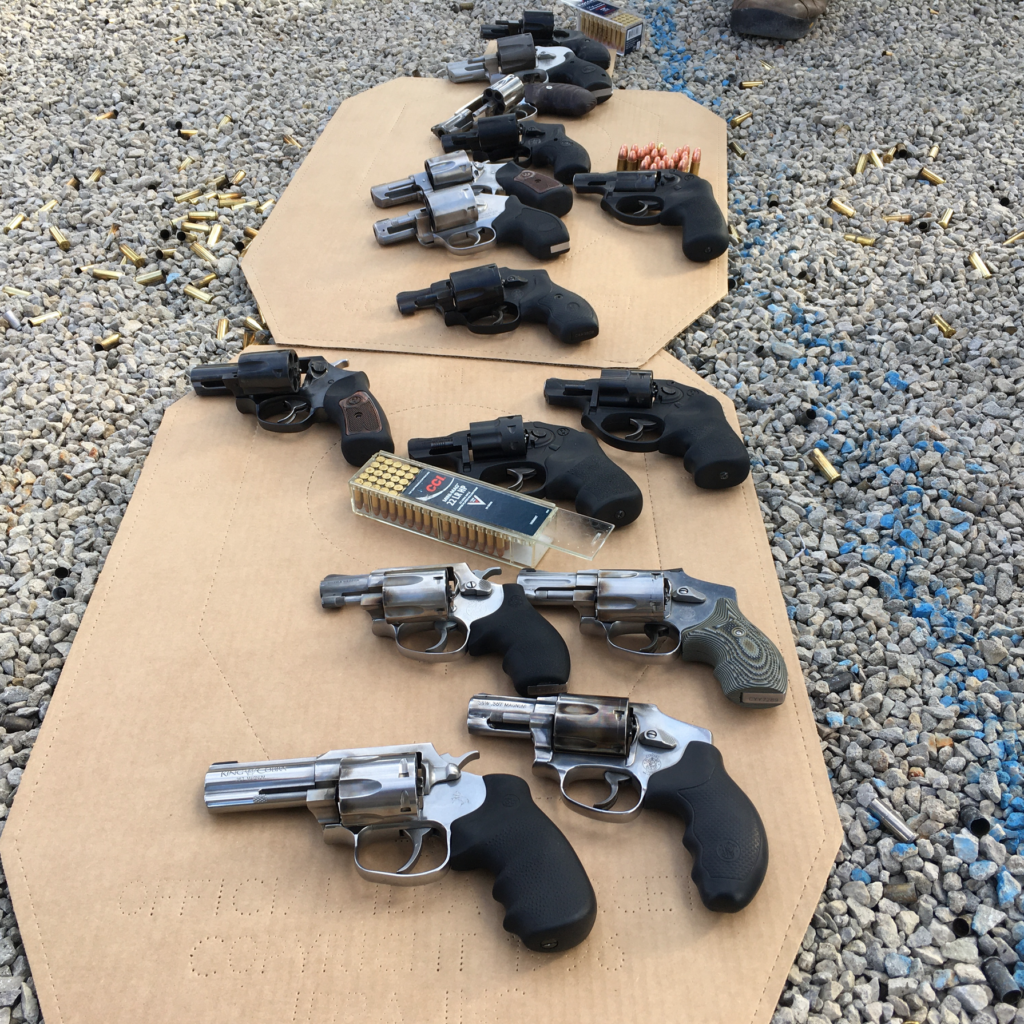
The part you guys are probably waiting to see is the guns, and here we are. I kept a list as people introduced themselves and what they were packing. I also tried to keep track of holsters, but missed a few. I tried to get photos of all the guns, but they were being moved around a bit. Also, there are a few in the photos not listed; at the end of the day people pulled out their backup guns and some toys. Here’s the list:
-
- Ruger LCR, .38 +P, Kydex AIWB
- S&W Model 60, 2″, DeSantis Nemesis pocket holster
- S&W 442, DeSantis Nemesis pocket holster
- S&W 640 Pro Series, VZ wraparound “Twister” grips, Muddy River Tactical Kydex holster
- S&W 640, .357 Magnum, OWB
- S&W 340, Crimson Trace laser grips, OWB
- Kimber K6S 2″, Muddy River Tactical AIWB (we’re working on getting one of these for review)
- Ruger SP101 (blued), S&W Model 36 (backup)
- S&W Model 64, 2″
- Ruger LCR .38 +P, OWB, Ruger LCR .22 LR
- S&W 640 Pro Series, Dark Star Gear AIWB, Ruger LCR 9mm
- (Greg) S&W Model 12, OWB leather thumb-break
A couple things about this list jump out at me. First, even though Smith & Wesson dominated the field there was more diversity than I expected. This was a really fun list. Secondly, everyone was shooting a .38, or a .357 with .38s in it (the .22 and 9mm LCRs on the list were brought along as backups). Thirdly, there wasn’t a low-end revolver in the bunch; everyone had a top-tier manufacturer’s logo on their belt. Fourth, there was a lot more Kydex and a lot more AIWB-carry than I expected.
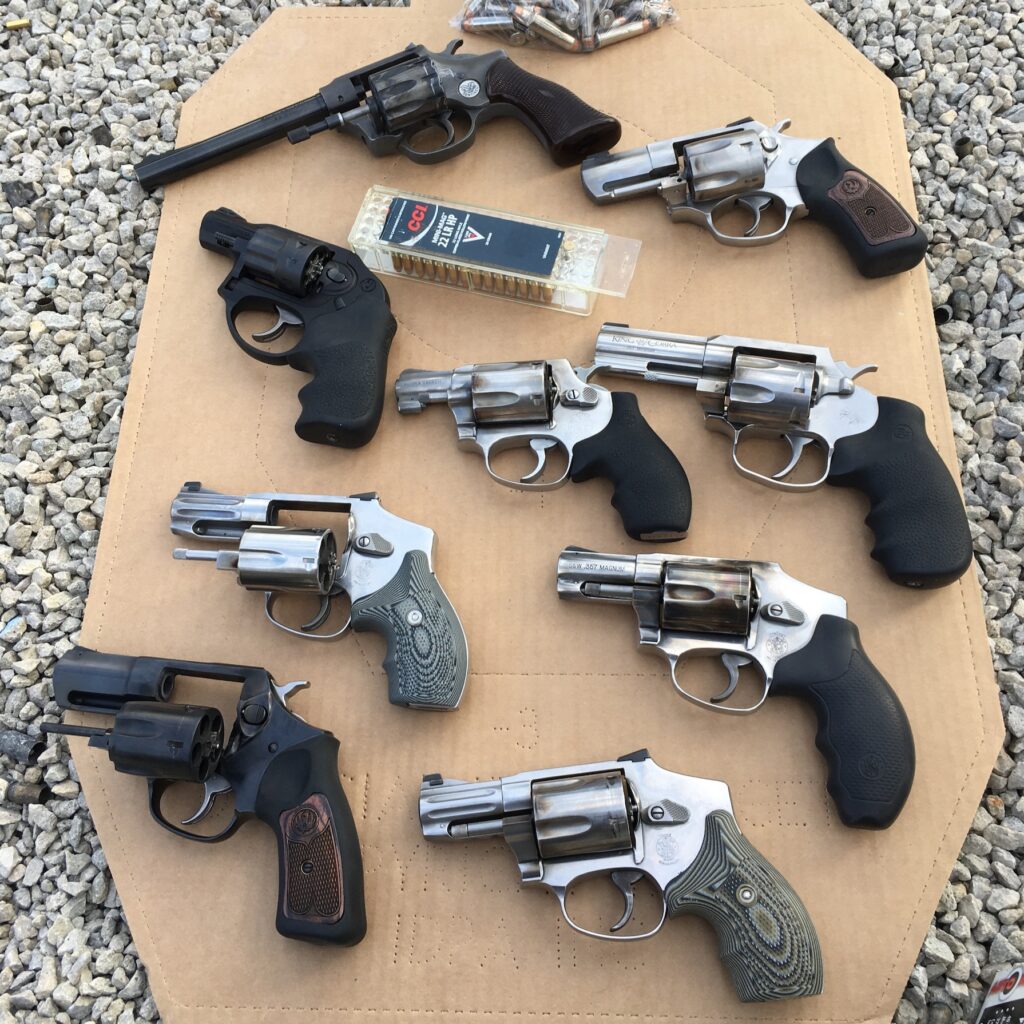
Finally, there were a lot of 640 Pro Series guns: three if you count mine. That’s a lot considering I’ve never encountered another one in the wild. I mentioned Neil’s 640 Pro, and he was gracious enough to share that he’d purchased it on the recommendations of Chris Baker and RevolverGuy. That was a pretty powerful reminder – and one that I don’t get every day – to keep our standards high here.
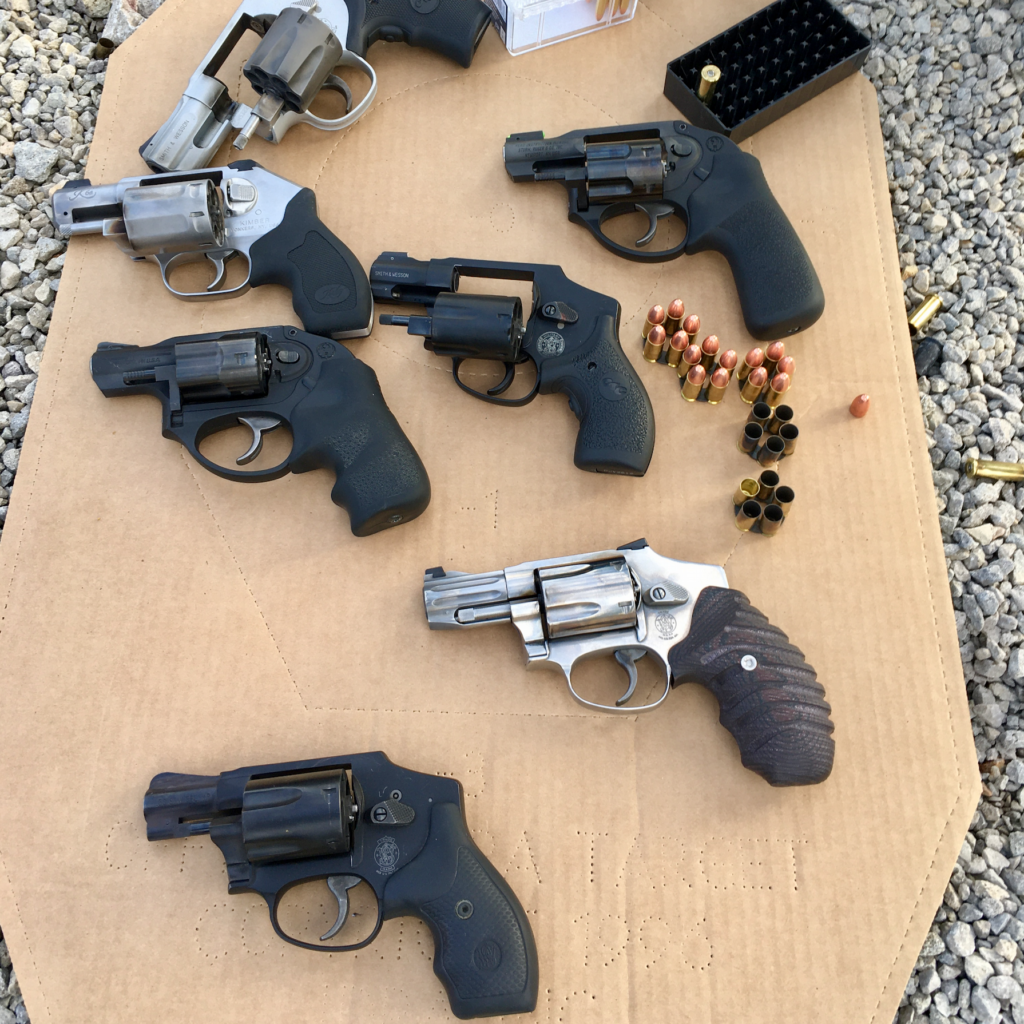
The end of the day was the most pure fun, and appealed to my inner revolver nerd: we go to pass around guns and shoot other people’s stuff. I wasn’t bashful: I shot Greg’s .22 Magnum Model 351, both of the Ruger SP101s, and Neil’s 9mm LCR. Also, Neil and I swapped our nearly-identical 640s just for fun (they felt pretty much exactly the same, as you’d expect). The weirdest gun I shot: Greg’s S&W Model 242, an extremely rare, 7-shot, humpback, ultra-light (19 ounces) L-frame in .38 Special. This little oddball was only manufactured for one year (1999).
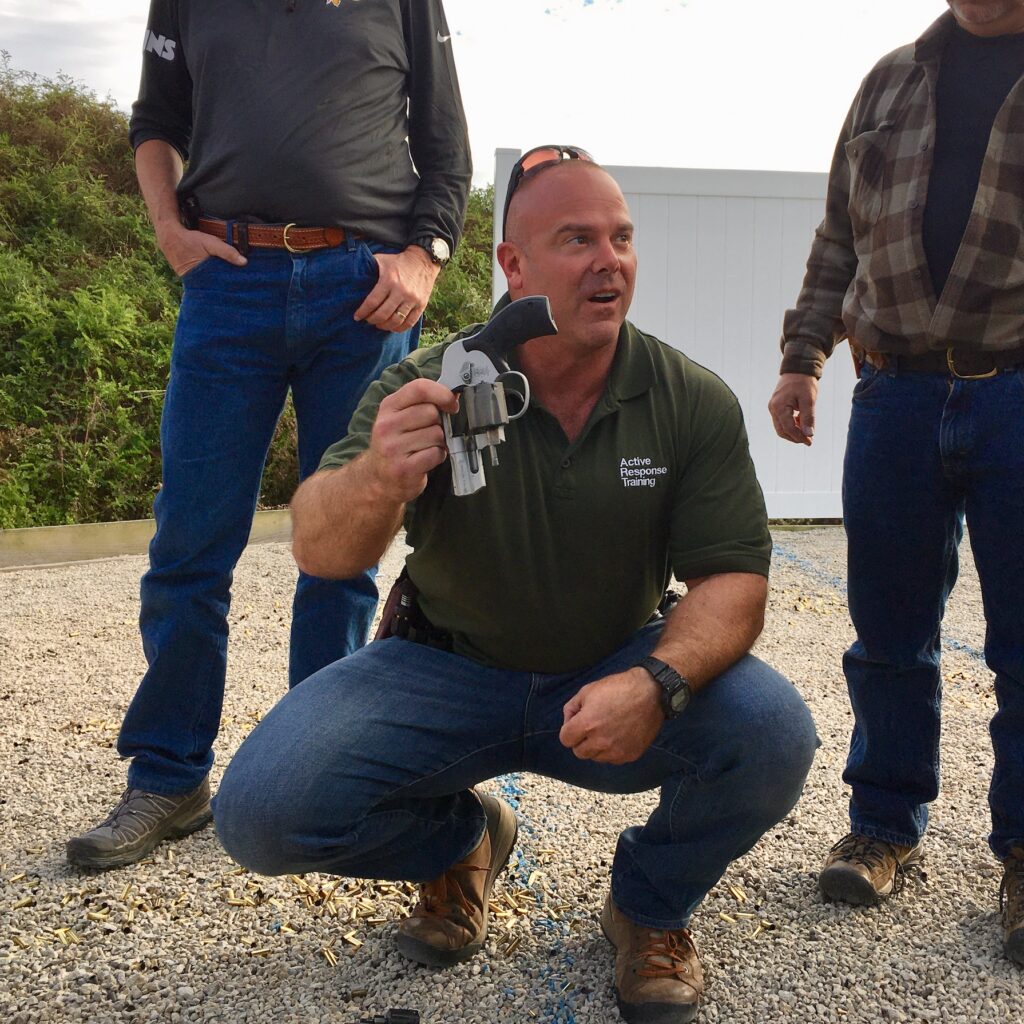
RevolverGuy Jim
I want to close out this AAR by talking about a fellow attendee named Jim. I hope he doesn’t mind, though something tells me he wouldn’t volunteer for the spotlight. I’m going to talk about him not only because I like him (I do), and not only because he was at the class (he was), but also because Jim is the antidote to last week’s post bemoaning the failings of revolvers. Jim is quick with a smile, friendly, and kind of quiet. If I’m being honest, he’s not the sort of guy you look at and think, “I wouldn’t want to mess with that dude.” But he’s not the sort of dude you’d want to mess with, and I’ll tell you why.
I met Jim last year at Chuck Haggard’s Practical Revolvers, where he gave me a beautiful breakfront holster (thank you!). I don’t know how much training Jim had before that, but he ran his GP100 very well and didn’t need a ton of one-on-one from Chuck. Now, a little over a year later he’s also showing up at Greg’s class, a good eight hours away from his home. This time he’s shooting the .38 LCR he normally carries, loaded up with wadcutters. This time he also showed up with the AIWB holster he had purchased and tried. It hadn’t worked out for him, but I was impressed with him for trying it. Let’s think about Jim for just a minute.
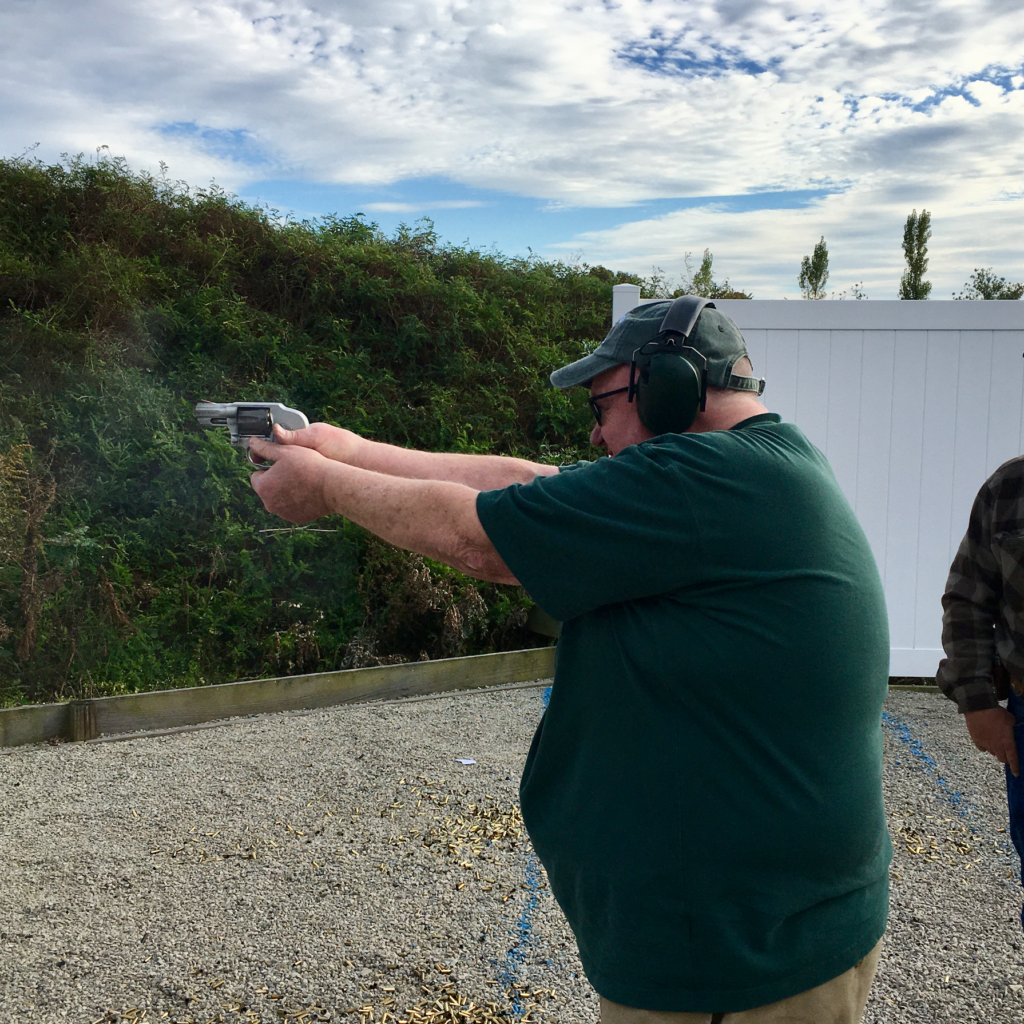
Here’s a guy who has been to not one but two revolver training classes in the past year, both requiring over 6 hours of driving each way. He’s spending a whole day in class shooting the lightweight .38 he actually carries. Instead of saying, “I’ve always carried OWB and I’ll never carry appendix!” he’s willing to try things out – even if they aren’t what he’s used to. If they don’t work, he’s honest enough to discard them and move on. And here’s a guy that scores a perfect score on Ohio’s Law Enforcement duty weapon qualification. With that .38 Special LCR. That’s why you wouldn’t want to mess with Jim.
The Bottom Line
Last week I talked about all the problems with revolvers. The willingness to get out to training, test your gear, modify the way you do things and practice, practice, practice is what makes the revolver a viable option. It’s also what takes a “viable option” and transforms it into a force to be reckoned with. Guys like Jim – guys like a lot of you, and all the guys attending this class – are doing the work. If you want to neutralize most of the issues with revolvers? Simple: just do the work.
Greg’s class was absolutely outstanding. I spoke to Greg about future revolver classes; he is about to release his 2020 schedule and at least two (maybe three) revolver classes should be on it (maybe he’ll consider a two-day ‘advanced’ class in the future?). He has also indicated he’ll keep teaching them as long as demand is there. My advice: register early and get to one. Greg is extremely knowledgeable and even if you’re a seasoned RevolverGuy he probably has a thing or two to teach you.
Support RevolverGuy
First, THANK YOU to our Patrons – we couldn’t do it without you guys! To the rest of you, please consider supporting us on Patreon – every little bit helps.

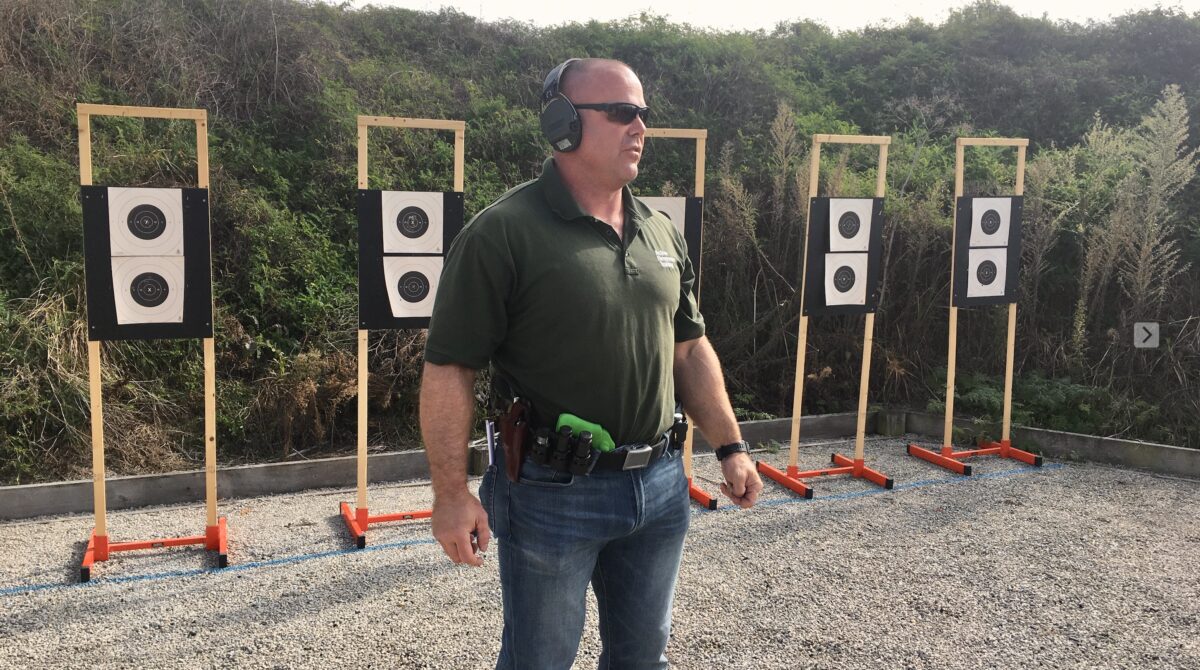

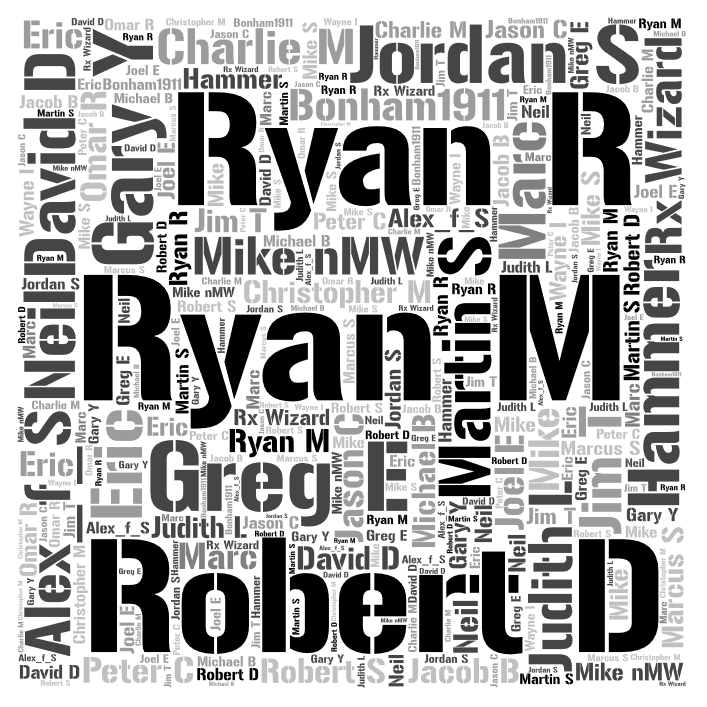
Thanks, Justin. I plan to attend a class, myself, as Greg offers one nearby.
I think Justin pretty much summed up everyone who attending felt about the class. I learned a lot and was given some new techniques to work on. If you get the opportunity to attend one of Greg’s classes, do it!
Very nice AAR. Greg is one of my favorite trainers and I look forward to seeing his revolver curriculum at some point.
Did you personally shoot 38s or .357s through your Colt for the class? What was Greg’s take on the sufficiency of 38s to stop an attack.
I shot .38s. As to the effectiveness of the .38, I don’t think Greg would disagree with anything said in our article on wadcutters a couple of weeks ago.
He doesn’t disagree with it. He linked your wadcutter article in his weekend knowledge dump two weeks back and said so.
Yep! That was a device to point that reader in the direction of more information. Thanks!
Justin, this was a terrific, thorough AAR… I was working on one, but you truly did the perfect review of this course and summarized my thoughts as well. As I said, I’ve discussed the idea of this course with Greg over several years… and all I can say is that Greg didn’t just knock the ball out of the park… he knocked it out of the state!
Greg is an excellent instructor… and this course made me think… and re-think… many things about carrying and using a snubby… and I say that as a former LEO back in the day who started with a six-shooter on his duty belt until the department eventually switched to the semi-autos…
Thank you again for the compliments and feedback on the facilities and range.
Thanks for the review, I do intend to get to one of Greg’s classes… If I can ever sort out family issues and leave time… I have to say though, I think of my three inch LCRX as a two person gun. Maybe I’m optimistic, maybe naive.
Justin, thanks your review and for your kind words! Greg did a great job with the instruction and packed a lot of content into a one day class. Dann has a great facility and I really appreciate his hospitality. I really enjoyed this class!
Jim, thanks for being a a great partner on the line. It was great to see you again, and I’m wondering what class we’ll be at next…
Justin,
I agree with your review! It was an honor to attend Greg’s inaugural snubby class! This was the first snubby class I’ve attended and couldn’t have been happier with the class, the range & hospitality at G4 Personal Safety and the other attendees. I learned a lot about how to shoot and reload the snubby more effectively and got a better understanding of the why behind the use of the snubby. I also enjoyed the “pass around”. What a great opportunity to shoot so many high quality revolvers. I look forward to taking additional classes with Greg.
Kevin,
It was great to meet you, and I’m really proud to have been a part of this cohort, too!
Justin
Outstanding!
Sounds like a lot of fun and an opportunity to meet great like minded people.
I’ve been able to attend a few gun training classes in my area in the past year and hope to find a revolver centered class in the future though most are heavily centered around semi autos.
I’m glad the class was worthwhile. I unfortunately lacked the money (and time) to attend, but at least now I know what I can expect if the opportunity does present itself in the future. Perhaps I’ll bring my own S&W Model 12, or my 642.
Justin, thank you for the thorough AAR (it also helped me fill in some gaps in my own notes). It was an absolute pleasure meeting you and some of the other RevolverGuys and both humbling and inspirational to shoot next to you on the line! I can’t recommend the class highly enough. Greg is a fantastic instructor and Dann’s communication as the host and excellent facility were top notch. I learned some new ways of doing things, validated some things I was already doing and now have some great drills with which to measure my proficiency with the snubby.
Neil,
It was great to meet you, too! That’s one of my favorite parts of these classes – getting to meet other attendees. I’m also really glad you got some good stuff out of it!
Justin
So much to consume here, Justin. Thanks for a great writeup!
I recently attended a one-day revolver class myself, and it was not as valuable an experience as what you had here. My class was less professionally run, and did not cover the variety of topics that yours did. It sounds like you covered a lot of ground, and that’s a credit to Greg’s preparation and skill.
The primed case drill is unique. I’ve not seen that one either. Having had the experience of shooting a real squib and a primed case, I’ll say that the squib feels and sounds different because of the bullet’s influence, but I see this as a valuable tool. It’s an excellent way to condition someone to putting on the brakes when something doesn’t feel or sound right while you’re firing. Very innovative.
Shooting through the pocket is an interesting addition to the class. We’ve seen it in magazines for decades, but how many shooters have actually done it? What a neat thing for Greg to expose the class to. The guys with external hammers might gain some benefit from flagging a thumb, to protect the arc of the hammer, but remembering to do that under stress could be problematic. After the first shot or two, the pocket is often so shredded that it’s no longer much of an impediment, and the gun can be thrust through it.
I like Greg’s technique of loading opposite chambers when you only have time to load a few singles by hand. I know the statisticians would argue that the odds are against any of us having to reload under fire, but that doesn’t bring me any comfort. If I’m in a gunfight, then the odds are already running against me that day, aren’t they? Since revolvers are slower to reload to begin with, it makes sense to me to practice a partial loading technique that would allow you to return to the fight sooner, in case circumstances force that. If brave Officer Pence had been exposed to something like that, he may have been able to kill his attacker before he was murdered at Newhall. I like the fact that Greg is thinking about this and getting his students to consider it—he’s adding an index card for them to have access to in the worst case.
I also like the fact that there was a performance test as part of the class. Shooting the quals gives you an objective measure of where you are, and gives you a way of checking and comparing your future performance. Many instructors, including the one who ran my class, won’t include that, but I think it’s important. Kudos to Greg for making that part of the day.
I also like the fact that you were able to fam fire other people’s guns. That’s a valuable experience in so many ways. The S&W shooter gets to learn that a Colt works differently, and everyone gets the benefit of being forced to work with a different tool than they’re used to. Even small changes in triggers, sights, or grips can make a difference, and it’s valuable to have to work your way through that and still perform. Once again, it’s neat that Greg thought to include it.
The equipment list is very interesting. Despite all the innovation we’ve seen from other makes in the last 20 years, it still remains a S&W world, doesn’t it? I’m constantly frustrated that S&W hasn’t poured any significant energy into upgrading their J-Frame revolvers—improving sights and triggers, for example—but it appears that the market isn’t forcing them to do it. Your class is just one data point, but if it’s any indicator, people are buying more S&Ws than other makes and are putting up with the weaknesses. From S&W’s perspective, why spend any effort to improve? Trials and tribulations of the RevolverGuy, indeed!
One thing I’d like to hear about, from an equipment perspective, is which loaders and carriers were being used by the participants. If you have any notes or recollection of that, please share. The carriers would be particularly interesting to me—were most guys just using pockets, or did they have dedicated carriers?
The AAR prompts many more thoughts and questions, but I’ve already run long. I suppose that’s a testament to the quality of the class and your report that someone who wasn’t there could have so much to comment and inquire about. I regret being unable to join you, but will certainly look forward to another opportunity down the road. It sounds like Greg is doing great work out there.
Mike,
Thanks for the very detailed response. To your question regarding loaders it was, as you would expect, a mix. There were a few Safarilands (Comp I/II), Jets, and even a Pachmayr aluminum loader (I learned something about this one). HKS was probably the most commonly encountered but the loader manufacturers were certainly more evenly varied than the guns. I wish I had kept better track. If anyone who attended is reading this, feel free to let us know what you were using!
The thing I learned about the Pachmayr loaders is thanks to Kevin, who shot beside me on the line in the opposite relay. I mentioned to him that mine had been excessively stiff. He told me just a drop of oil would fix ’em up and they did. Thanks for reminding me of that – not I’m going to have to go back and update my review of that loader.
Justin
Thanks Justin! Wish I’d been there with you guys.
Good info on the Pachmayr loader. Thanks Kevin.
Any trends you noticed with carriers/pouches? Were most guys loading from a pocket, or were they carrying the round body loaders in pouches?
Mike, I would have a hard time saying with any authority what people were using to carry their loaders. I saw a few pouches on belts, but a lot of shooters were shooting from concealment. There was some mixed-bag carry, too; for example some of the drills were fast enough that I had to put my first speedloader in the DeSantis Second Six, and two more in my hip pocket.
Mike,
I had settled on the Jet-Loader in the right (dominant hand) pants or jacket pocket but also used the Comp I in the course. I find the bulk of the JL is offset by the ability to index it easily. I keep working with the Comp I but often find it doesn’t release the rounds smoothly without extra effort on my part (thus extending an already slow reloading process).
I had been working quite a bit with speed strips during dry practice and at the range trying to figure out the best way for me to set them up. After using them during the class and refining my technique thanks to Greg’s instruction (pulling the strip toward me to release the round made a huge difference) I am comfortable carrying them as a reloading option. However, I would only choose them over the JL as a second reload or if I needed to take advantage of their low profile. I like the 6 round Bianchi Speed Strips and the 8 round Tuff QuickStrips (I find the 6 round Tuff strips to be too stiff). I found them quite easy to index out of my right back pocket.
Thanks Neil! Do you carry the JL and Comp 1 in the pants pocket in the real world, or just for class? If so, how does that work out on a daily basis?
My experience with the JetLoader is that it requires the cylinder to be free to rotate to get a clean release. Since my reloading techniques all involve trapping the cylinder in place, that loader didn’t work so well for me. I do think it would be an excellent loader for those Right Handers who want to load the gun with their Left Hand.
Mike,
I do carry that way in the real world. Justin was kind enough to let me try out a belt-mounted kydex holder for the JL during class. I didn’t realize it was supposed to be worn IWB so I was wearing it the opposite way. I didn’t like that it kept sliding around but that was obviously user error as it would have stayed put IWB. I have considered purchasing one of these but one of the reasons I got into revolvers for concealed carry was in those situations where I wasn’t wearing a belt (gym shorts, sweatpants, etc.). I do like the flexibility the speed loaders provide in those circumstances and find pocket carry of the reload to be both convenient and generally comfortable.
I’m going to play around with my reloading technique based on your issue with the JetLoader. Of the three speed loaders I have (JL, HKS, and Comp I) I am fastest with the JL and have the fewest issues with that one when it comes to getting a clean reload. I use the universal revolver reload technique but now I think about it I do not lock the cylinder in place with my thumb but allow it to rotate a bit by having my thumb “floating” just off the cylinder as I’m inserting the rounds. I’m definitely going to look at refining my technique based on your comment so thank you for the insight!
Neil, if it’s working for you, I wouldn’t change a thing! There’s a lot of ways to get the job done effectively. Thanks for the extra info—it’s always good to compare notes with other guys to see what they’re doing and what’s working for them
I was using a Speed Beez and 5 star for my Kimber K6s. HKS for the Ruger Sp101. While I enjoyed using these in a controlled environment such as Greg’s class, I think I’ll continue to carry my speed strips for everyday carry. The loaders are to bulky and if I had a pouch for my belt I feel that it would be a giveaway that I was carrying.
Good info David, thanks! Glad you made the class!
Fantastic review! I look forward to the opportunity to take such a focused and well put together revolver class.
As so happens, after reading your article about the tribulations of being a wheelgunner…one of my students showed up with a Snubbie!! I was elated. After some providing some tips on managing the trigger, she…yep, SHE…flat out ran that gun!
Proof that the round gun club is still out there!!
Thanks again for taking the time to write such a great AAR.